Triticale in Mediterranean Cereal Farming: Opportunity or Reality?
Abstract
1. Introduction
1.1. What Is Triticale?
1.2. Importance of Triticale
1.3. Breeding of Triticale in Mediterranean Regions
2. Triticale Assets
2.1. The Grain Yield of Triticale Is Greater Than That of Other Cereals
2.2. Triticale Forage Yield and Quality Is Greater Than Those of Other Cereals
2.3. Triticale Cultivation Has Less Weed Growth
2.4. Triticale Is More Resistant to Pests and Diseases than Other Cereals
2.5. Triticale Is More Tolerant to Abiotic Stresses Than Other Cereals
3. Triticale in Spain
4. Triticale in Türkiye
5. Can Triticale Expand in the Mediterranean Basin as It Has in Spain and Türkiye?
5.1. Market Development
5.2. The Success of Triticale in Spain and Türkiye
5.3. Increasing Population and Meat Consumption in MENA Countries
5.4. Triticale for Food
6. Conclusions
Author Contributions
Funding
Acknowledgments
Conflicts of Interest
References
- Ammar, K.; Mergoum, M.; Rajaram, S. The history and evolution of triticale. In Triticale Improvement and Production; Mergoum, M., Gómez-Macpherson, H., Eds.; FAO: Rome, Italy, 2004; pp. 1–10. Available online: https://www.fao.org/4/y5553e/y5553e.pdf (accessed on 9 September 2025).
- Mergoum, M.; Pfeiffer, W.H.; Peña, R.J.; Ammar, K.; Rajaram, S. The history and evolution of triticale. Triticale crop improvement: The CIMMYT programme. In Triticale Improvement and Production; Mergoum, M., Gómez-Macpherson, H., Eds.; FAO: Rome, Italy, 2004; pp. 11–26. Available online: https://www.fao.org/4/y5553e/y5553e.pdf (accessed on 9 September 2025).
- FAOSTAT (Global Food and Agriculture Statistics of FAO). Available online: https://www.fao.org/faostat/en/#home (accessed on 9 September 2025).
- OEC (The Observatory of Economic Complexity). Available online: https://oec.world/en/profile/hs/cereals-triticale (accessed on 9 September 2025).
- Myer, R.; Lozano del Río, A.J. Triticale as animal feed. In Triticale Improvement and Production; Mergoum, M., Gómez-Macpherson, H., Eds.; FAO: Rome, Italy, 2004; pp. 49–58. Available online: https://www.fao.org/4/y5553e/y5553e.pdf (accessed on 9 September 2025).
- Kottek, M.; Grieser, J.; Beck, C.; Rudolf, B.; Rubel, F. World map of the Köppen-Geiger climate classification updated. Meteorol. Z. 2006, 15, 259–263. [Google Scholar] [CrossRef] [PubMed]
- Varughese, G.; Barker, T.; Saari, E. Triticale; CIMMYT: Mexico City, Mexico, 1987; 32p, Available online: https://repository.cimmyt.org/bitstreams/727b40c5-050e-4227-b15c-cc0b5a9b69ac/download (accessed on 9 September 2025).
- Motzo, R.; Pruneddu, G.; Virdis, A.; Giunta, F. Triticale vs. durum wheat: A performance comparison in a Mediterranean environment. Field Crops Res. 2015, 180, 63–71. [Google Scholar] [CrossRef]
- Solís, I. El Triticale en España. Nuevas variedades Agrovegetal-CIMMYT para la producción de grano y ensilados para la alimentación animal. In Proceedings of the Segundo Taller Nacional de Triticale, Toluca, Mexico, 3 October 2024; Available online: https://www.agrovegetal.es/documentacion/ (accessed on 9 September 2025).
- Benbelkacem, A. Triticale in Algeria. In Triticale Improvement and Production; Mergoum, M., Gómez-Macpherson, H., Eds.; FAO: Rome, Italy, 2004; pp. 81–86. Available online: https://www.fao.org/4/y5553e/y5553e.pdf (accessed on 9 September 2025).
- Villegas, D.; Casadesús, J.; Atienza, S.G.; Martos, V.; Maalouf, F.; Karam, F.; Aranjuelo, I.; Nogués, S. Tritordeum, wheat and triticale yield components under multi-local mediterranean drought conditions. Field Crops Res. 2010, 116, 68–74. [Google Scholar] [CrossRef]
- Kucukozdemir, U.; Bedirhanoglu, V.; Bagci, S.A. Comparison of Some Triticale and Wheat Varieties in Terms of Yield Over the Locations and Years in Erzurum Conditions. Ekin J. 2020, 6, 54–62. [Google Scholar]
- Varughese, G.; Pfeiffer, W.H.; Peña, R.J. Triticale (Part 1): A successful alternative crop. Cereal Foods World 1996, 41, 474–482. [Google Scholar]
- Cui, L.; Xu, L.; Wang, H.; Fan, X.; Yan, C.; Zhang, Y.; Jiang, C.; Zhou, T.; Guo, Q.; Sun, Y.; et al. Evaluation of Dual-Purpose Triticale: Grain and Forage Productivity and Quality Under Semi-Arid Conditions. Agronomy 2025, 15, 881. [Google Scholar] [CrossRef]
- Lozano, A.J.; Zamora, V.M.; Diaz-Solis, H.; Mergoum, M.; Pfeiffer, W.H. Triticale forage production and nutritional value in the northern region of Mexico. In Proceedings of the 4th International Triticale Symposium, Red Deer, AB, Canada, 26–31 July 1998; Volume 2. [Google Scholar]
- Baron, V.S.; Juskiw, P.E.; Aljarrah, M. Triticale as a Forage. In Triticale; Eudes, F., Ed.; Springer: Lethbridge, AB, Canada, 2015; pp. 189–212. Available online: https://link.springer.com/book/10.1007/978-3-319-22551-7 (accessed on 9 September 2025).
- Harper, M.T.; Oh, J.; Giallongo, F.; Roth, G.W.; Hristov, A.N. Inclusion of wheat and triticale silage in the diet of lactating dairy cows. J. Dairy Sci. 2017, 100, 6151–6163. [Google Scholar] [CrossRef] [PubMed]
- Ciftci, E.A.; Kinabas, S.; Yelbey, S.; Yagdi, K. Research of the quality traits and breadmaking property of some triticale lines. J. Agric. Fac. Uludag Univ. 2010, 24, 93–102. [Google Scholar]
- Fraś, A.; Gołębiewska, K.; Gołębiewski, D.; Mańkowski, D.R.; Boros, D.; Szecówka, P. Variability in the chemical composition of triticale grain, flour and bread. J. Cereal Sci. 2016, 71, 66–72. [Google Scholar] [CrossRef]
- Xu, R.; Sun, Q. Comparative Analysis of Triticale and Wheat: Yield, Adaptability, and Nutritional Content. BioPublisher 2024, 7. Available online: https://cropscipublisher.com/index.php/fc/article/html/3970/ (accessed on 9 September 2025).
- Zhu, F. Triticale: Nutritional composition and food uses. Food Chem. 2018, 241, 468–479. [Google Scholar] [CrossRef]
- Boros, D. Physico-chemical indicators suitable in selection of triticale for high nutritive value. In Proceedings of the 5th International Triticale Symposium, Radzikow, Poland, 30 June–5 July 2002. [Google Scholar]
- Beres, B.L.; Harker, K.N.; Clayto, G.W.; Bremer, E.; Blacksha, R.E.; Graf, R.J. Weed competitive ability of spring and winter cereals in the Northern Great Plains. Weed Technol. 2010, 24, 108–116. [Google Scholar] [CrossRef]
- Bertholdsson, N.O. Allelopathy—A Tool to Improve the Weed Competitive Ability of Wheat with Herbicide-Resistant Black-Grass (Alopecurus myosuroides Huds.). Agronomy 2012, 2, 284–294. [Google Scholar] [CrossRef]
- Reiss, A.; Fomsgaard, I.S.; Mathiassen, S.K.; Kudsk, P. Weed suppressive traits of winter cereals: Allelopathy and competition. Biochem. Syst. Ecol. 2018, 76, 35–41. [Google Scholar] [CrossRef]
- Carton, N.; Naudin, C.; Piva, G.; Corre-Hellou, G. Intercropping Winter Lupin and Triticale Increases Weed Suppression and Total Yield. Agriculture 2020, 10, 316. [Google Scholar] [CrossRef]
- Kir, H.; Yilar, M.; Yavuz, T. Comparison of Alternative Sowing Methods in Hungarian Vetch and Triticale Cultivation in Terms of Yield and Weed Biomass. Gesunde Pflanz. 2023, 75, 253–260. [Google Scholar] [CrossRef]
- Jastrzebska, M.; Kostrzewska, M.K.; Marks, M. Is Diversified Crop Rotation an Effective Non-Chemical Strategy for Protecting Triticale Yield and Weed Diversity? Agronomy 2023, 13, 1589. [Google Scholar] [CrossRef]
- Royo, C.; Villegas, D.; García del Moral, L.F. Triticale in Spain. In Triticale Improvement and Production; Mergoum, M., Gómez-Macpherson, H., Eds.; FAO: Rome, Italy, 2004; pp. 139–148. Available online: https://www.fao.org/4/y5553e/y5553e.pdf (accessed on 9 September 2025).
- Menardo, F.; Praz, C.R.; Wyder, S.; Ben-David, R.; Bourras, S.; Matsumae, H.; McNally, K.E.; Parlange, F.; Riba, A.; Roffler, S.; et al. Hybridization of powdery mildew strains gives rise to pathogens on novel agricultural crop species. Nat. Genet. 2016, 48, 201–205. [Google Scholar] [CrossRef]
- Singh, S.J.; McIntosh, R.A. Linkage and expression of genes for resistance to leaf rust and stem rust in triticale. Genome 1990, 33, 115–118. [Google Scholar] [CrossRef]
- Bender, C.M.; Boshoff, W.H.P.; Pretorius, Z.A. Infection and colonization of triticale by Puccinia graminis f. sp. tritici. Can. J. Plant Pathol. 2021, 43, S198–S210. [Google Scholar] [CrossRef]
- Zhang, J.; Wellings, C.R.; McIntosh, R.A.; Park, R.F. Seedling resistances to rust diseases in international triticale germplasm. Crop Pasture Sci. 2010, 61, 1036–1048. [Google Scholar] [CrossRef]
- Tyrka, M.; Chełkowski, J. Enhancing the resistance of triticale by using genes from wheat and rye. J. Appl. Genet. 2004, 45, 283–295. [Google Scholar] [PubMed]
- Hovmøller, M.S.; Walter, S.; Bayles, R.A.; Hubbard, A.; Flath, K.; Sommerfeldt, N.; Leconte, M.; Czembor, P.; Rodriguez-Algaba, J.; Thach, T.; et al. Replacement of the European wheat yellow rust population by new races from centre of diversity in the near-Himalayan region. Plant Pathol. 2016, 65, 402–411. [Google Scholar] [CrossRef]
- Ding, Y.; Cuddy, W.S.; Wellings, C.R.; Zhang, P.; Thach, T.; Hovmøller, M.S.; Qutob, D.; Brar, G.S.; Kutcher, H.R.; Park, R.F. Incursions of divergent genotypes, evolution of virulence and host jumps shape a continental clonal population of the stripe rust pathogen Puccinia striiformis. Mol. Ecol. 2021, 30, 6566–6584. [Google Scholar] [CrossRef] [PubMed]
- Kroupin, P.Y.; Gruzdev, I.V.; Divashuk, M.G.; Bazhenov, M.S.; Kocheshkova, A.A.; Chernook, A.G.; Dudnikov, M.V.; Karlov, G.I.; Soloviev, A.A. Analysis of Spring Triticale Collection for Leaf Rust Resistance Genes with PCR Markers. Russ. J. Genet. 2019, 55, 945–954. [Google Scholar] [CrossRef]
- Blum, A. The Abiotic Stress Response and Adaptation of Triticale—A Review. Cereal Res. Commun. 2014, 42, 359–375. [Google Scholar] [CrossRef]
- Bouraoui, N.K.; Zid, E.; Grignon, C. K/Na selectivity for secretion into the xylem in triticale (X-Triticosecale Wittmack). In Plant Nutrition. Developments in Plant and Soil Sciences; Horst, W.J., Schenk, M.L., Bürkert, A., Claassen, N., Flessa, H., Frommer., W.B., Wirén., N.v., Goldbach, H., Olfs, H.-W., Römheld, V., et al., Eds.; Springer: Dordrecht, The Netherlands, 2001; Volume 92, pp. 420–421. [Google Scholar] [CrossRef]
- Mergoum, M.; Singh, P.K.; Peña, R.J.; Lozano-Del Río, A.J.; Cooper, K.V.; Salmon, D.F.; Gómez Macpherson, H. Triticale: A “New” Crop with Old Challenges. In Cereals; Carena, M., Ed.; Springer: New York, NY, USA, 2009; pp. 267–287. [Google Scholar] [CrossRef]
- Jessop, R.S. Stress Tolerance in Newer Triticales Compared to Other Cereals. In Triticale: Today and Tomorrow. Developments in Plant Breeding; Guedes-Pinto, H., Darvey, N., Carnide, V.P., Eds.; Kluwer Academic Publishers: Dordrecht, The Netherlands, 1996; pp. 419–428. [Google Scholar]
- Hayes, J.E.; Ma, J.F. Al-induced efflux of organic acid anions is poorly associated with internal organic acid metabolism in triticale roots. J. Exp. Bot. 2003, 54, 1753–1759. [Google Scholar] [CrossRef]
- Wagatsuma, T.; Ishikawa, S.; Uemura, M.; Mitsuhashi, W.; Kawamura, T.; Khan, M.S.H.; Tawaraya, K. Plasma membrane lipids are the powerful components for early stage aluminum tolerance in triticale. Soil Sci. Plant Nutr. 2005, 51, 701–704. [Google Scholar] [CrossRef]
- Cakmak, I.; Torun, B.; Erenoçlu, B.; Öztürk, L.; Marschner, H.; Kalayci, M.; Ekiz, H.; Yilmaz, A. Morphological and physiological differences in the response of cereals to zinc deficiency. Euphytica 1999, 100, 349–357. [Google Scholar] [CrossRef]
- Beji, S. Yield and quality of dual-purpose barley and triticale in a semi-arid environment in Tunisia. Afr. J. Agric. Res. 2016, 11, 2730–2735. [Google Scholar]
- Mergoum, M. Programme d’amelioration genetique des triticales au Maroc. In Constitution de Reseaux Thematiques de Recherche Agricole au Maghreb; Birouk, A., Ouhsine, A., Ameziane, T.E., Eds.; Edition Actes: Rabat, Morocco, 1989; pp. 127–130. [Google Scholar]
- Mergoum, M.; Ryan, J.; Shroyer, J.P. Triticale in Morocco: Potential for adoption in the semi-arid cereal zone. J. Nat. Res. Life Sci. Edu. 1992, 21, 137–141. [Google Scholar] [CrossRef]
- Mergoum, M.; Sapkota, S.; El Fatih, A.; Naraghi, S.; Pirseyedi, S.; Abu Hammad, W. Triticale (x Triticosecale Wittmack) Breeding. In Advances in Plant Breeding Strategies: Cereals; Springer Nature: Cham, Switzerland, 2019; Volume 5, pp. 405–451. [Google Scholar]
- MAPA. Anuario de Estadística. Available online: https://www.mapa.gob.es/es/estadistica/temas/publicaciones/anuario-de-estadistica/default.aspx (accessed on 9 September 2025).
- Semillas Fitó. Misionero. Available online: https://www.semillasfito.es/productos/gran-cultivo/forrajeras/gram%C3%ADneas/misionero/ (accessed on 9 September 2025).
- MAPA. Producción de Semilla Certificada en España. Available online: https://www.mapa.gob.es/es/agricultura/estadisticas/estadisticas-semillas (accessed on 9 September 2025).
- Agrovegetal. Available online: https://www.agrovegetal.es/ (accessed on 9 September 2025).
- Tuik (Turkish Statistical Institute). Available online: www.tuik.gov.tr (accessed on 9 September 2025).
- Geren, H.; Ünsal, R. Tritikale tarımı. Tarım Türk Dergisi. Ocak-Şubat 2008, 9, 63–64. [Google Scholar]
- Ünver, S. Bazı tritikale hatlarında verim ve verim öğelerinin incelenmesi. Tarla Bitk. Merk. Araştırma Enstitüsü Derg. 1999, 8, 82–92. [Google Scholar]
- Özer, E.; Taner, S.; Göçmen-Akçacik, A. 2010. Konya şartlarında Tritikale’nin (Triticosecale Witt.) yeşil ot potansiyeli ile bazı tarımsal özellikleri. J. Crop Res. 2010, 1, 17–22. [Google Scholar]
- Ministry of Agriculture and Forestry of Türkiye. Available online: https://www.tarimorman.gov.tr/ (accessed on 9 September 2025).
- Anonymous. Tohumluk Tescil ve Sertifikasyon Merkez Müdürlüğü. 2020. Available online: https://www.tarimorman.gov.tr/BUGEM/TTSM (accessed on 9 September 2025).
- Fohner, G.R.; Hernández-Sierra, A. Triticale Marketing: Strategies for Matching Crop Capabilities to User Needs. In Triticale Improvement and Production; Mergoum, M., Gómez-Macpherson, H., Eds.; FAO: Rome, Italy, 2004; pp. 139–148. Available online: https://www.fao.org/4/y5553e/y5553e.pdf (accessed on 9 September 2025).
- CICYTEX. Agronomía y Selección del Triticale en Extremadura. 2013. Available online: https://cicytex.juntaex.es/-/agronomia-y-seleccion-del-triticale-en-extremadura (accessed on 9 September 2025).
- Kizilgeçi, F.; Yıldırım, M. Bazı tritikale (X Triticosecale Wittmack) genotiplerinin verim ve kalite özelliklerinin belirlenmesi. Turk. J. Agric. Res. 2017, 4, 43–49. [Google Scholar] [CrossRef][Green Version]
- UHK. Ulusal Hububat Konseyi (Tritikale Raporu). 2015. Available online: https://uhk.org.tr/dosyalar/uhkarpa_kasim2015.pdf (accessed on 9 September 2025).[Green Version]
- World Bank Group. World Population. 2025. Available online: https://data.worldbank.org/indicator/SP.POP.TOTL?locations=ZQ (accessed on 9 September 2025).[Green Version]
- AHDB (2025). Available online: https://ahdb.org.uk/trade-and-policy/export-opps/regions/mena/consumption (accessed on 9 September 2025).[Green Version]
- Peña, R.J. Food uses of triticale. In Triticale Improvement and Production; Mergoum, M., Gómez-Macpherson, H., Eds.; FAO: Rome, Italy, 2004; pp. 37–48. Available online: https://www.fao.org/4/y5553e/y5553e.pdf (accessed on 9 September 2025).[Green Version]
- Ramírez, A.G.; Pérez, G.R.; Franco, F.D.; Ortiz, F.C. Composición nutricional en granos de triticales (X. Triticosecale Wittmack) y usos alimentarios. Biotecnia 2023, 25, 44–51. [Google Scholar][Green Version]
- Coşkuner, Y.; Karababa, E. Studies on the quality of Turkish flat breads based on blends of triticale and wheat flour. Int. J. Food Sci. Technol. 2005, 40, 469–479. [Google Scholar] [CrossRef]
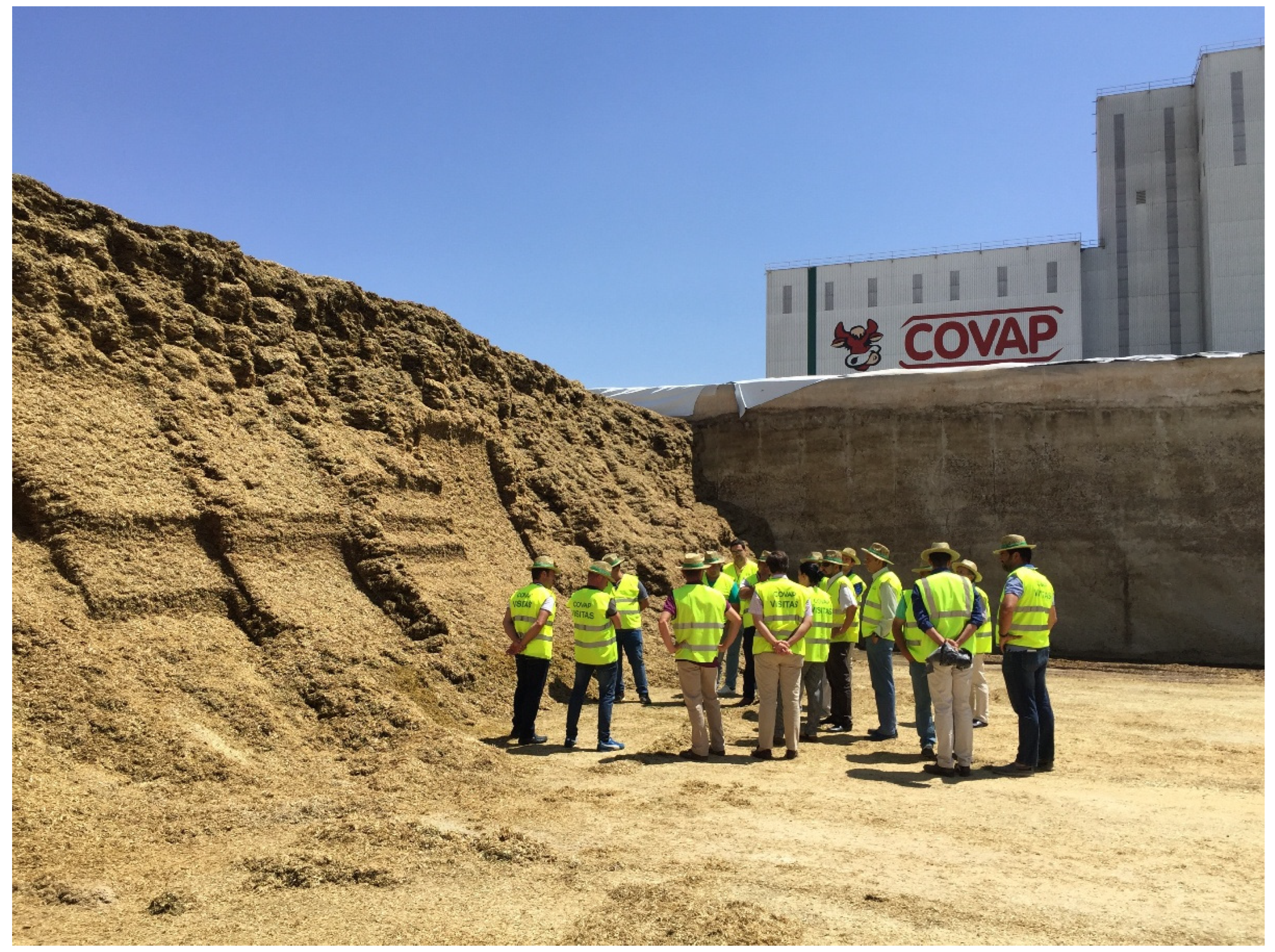

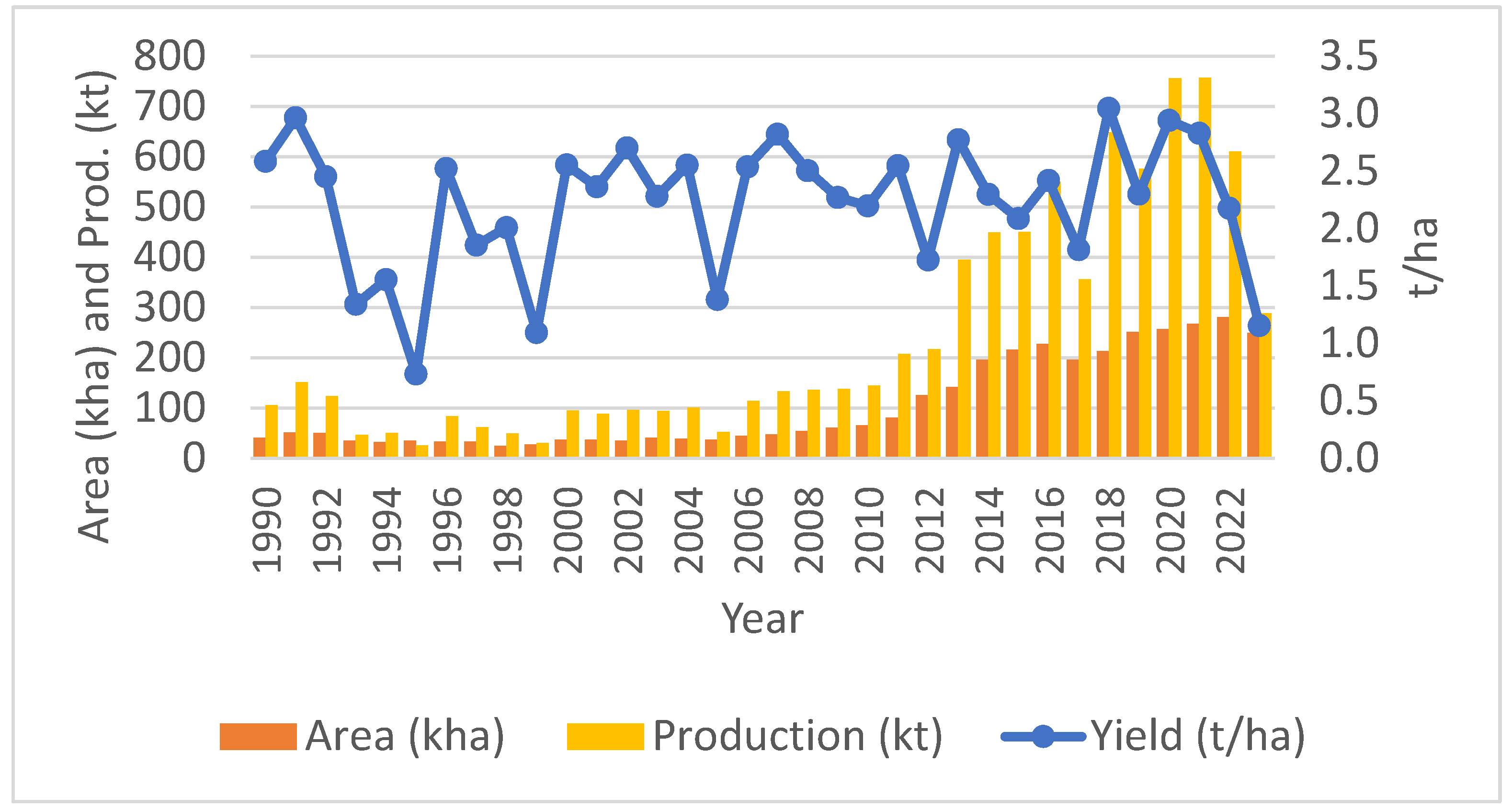
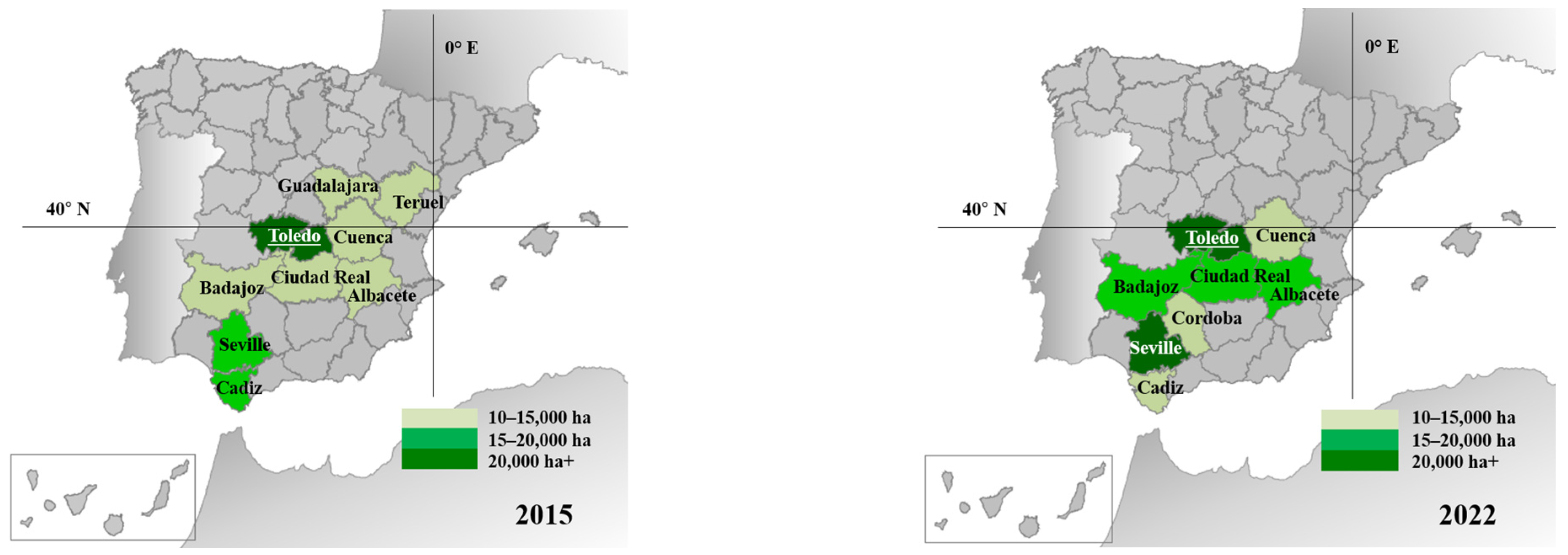
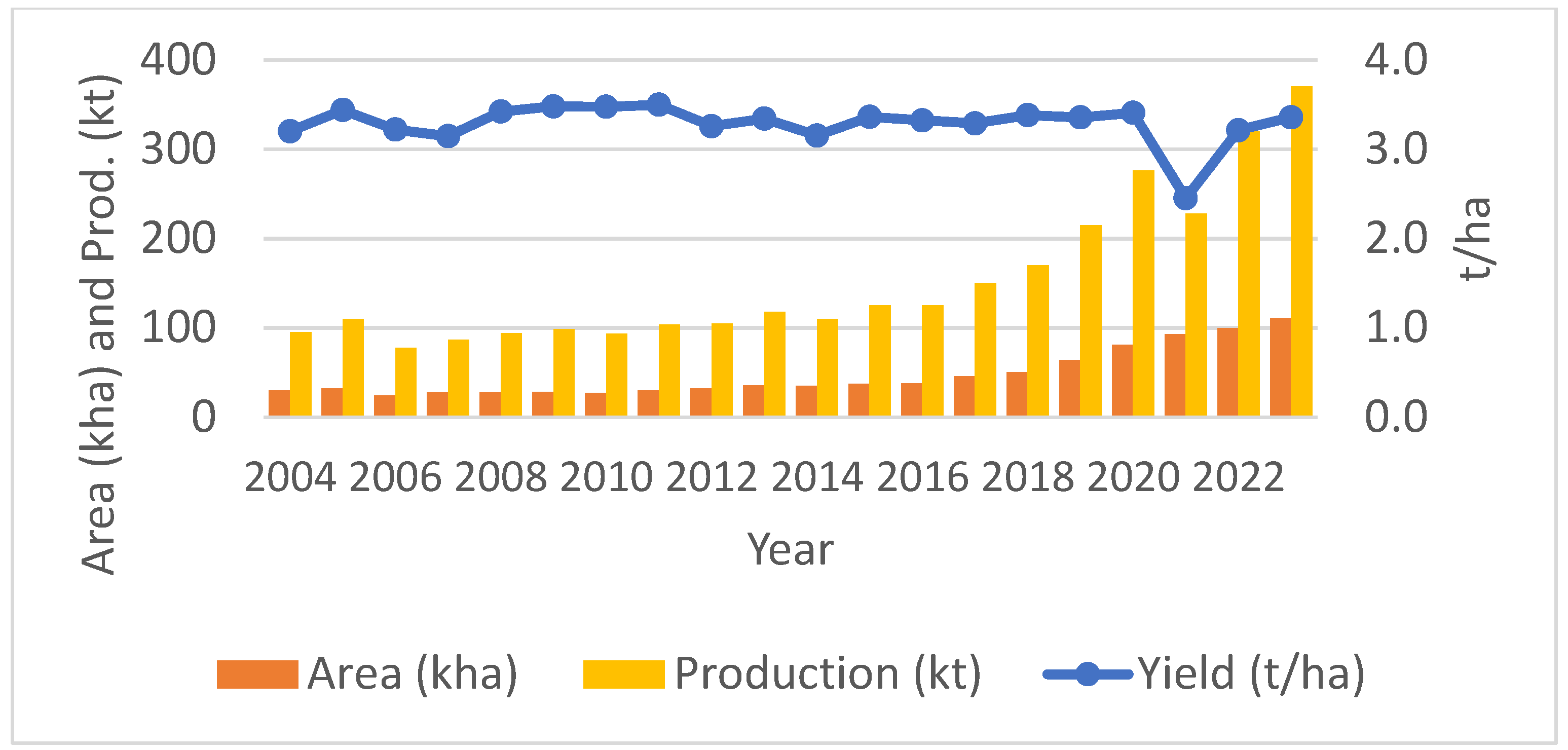
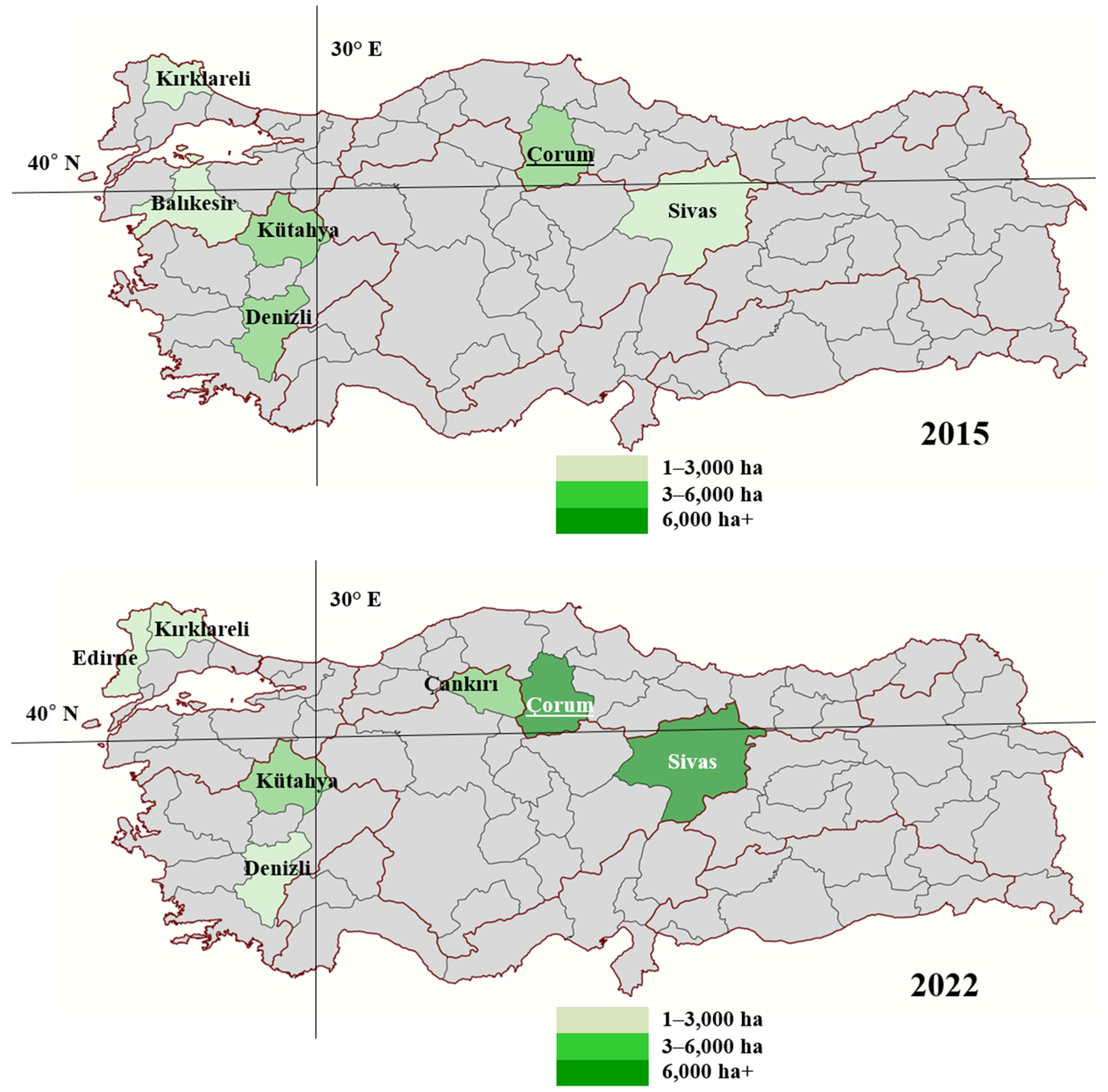

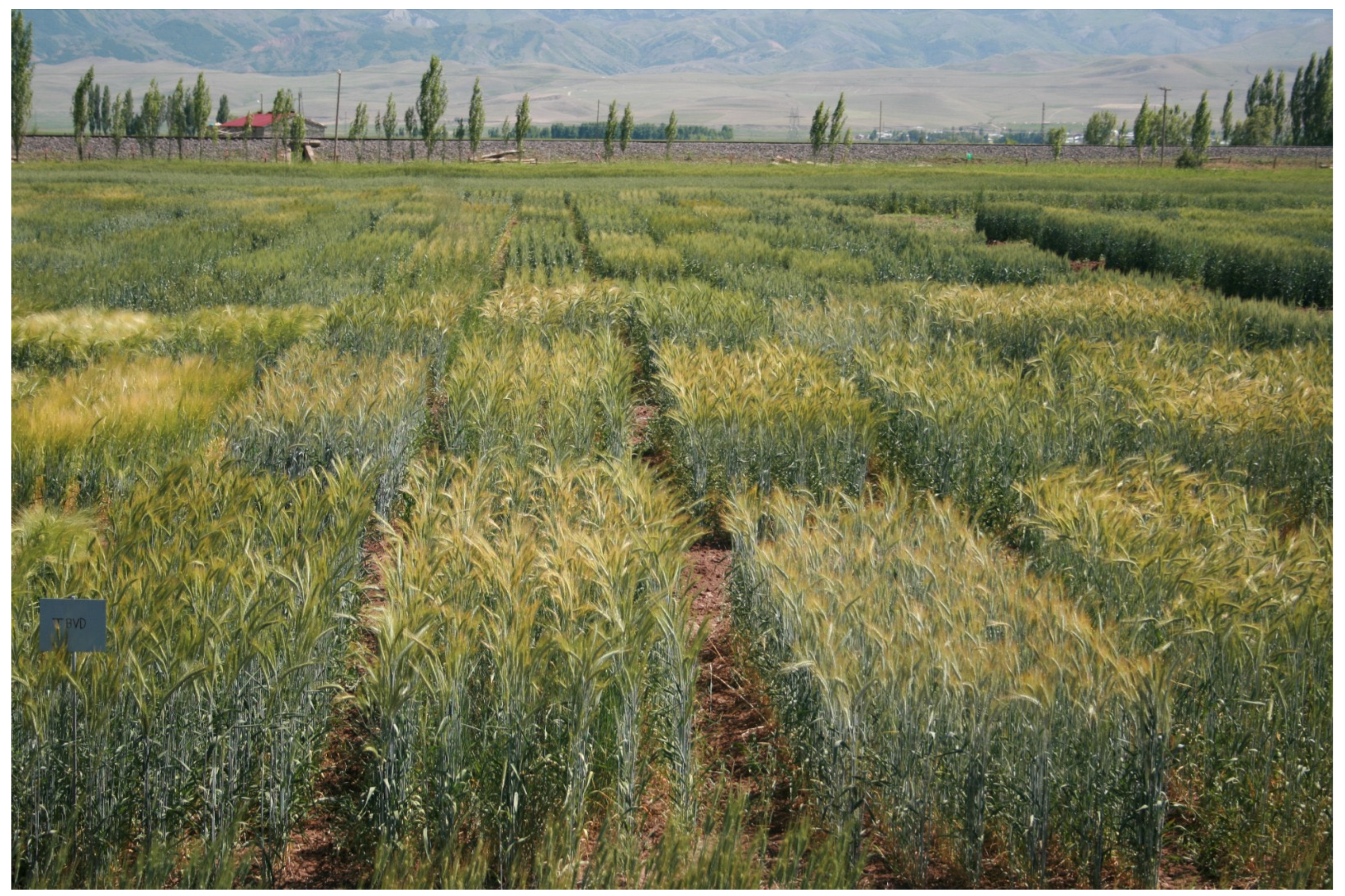
| Rank | Season/Country | Area/Prod. * | Season/Country | Area/Prod. | Season/Country | Area/Prod. | Season/Country | Area/Prod. |
|---|---|---|---|---|---|---|---|---|
| 2000/01 | 2008/09 | 2015/16 | 2022/23 | |||||
| 1 | Poland | 695/1901 | Poland | 1334/4460 | Poland | 1516/5339 | Poland | 1233/5440 |
| 2 | Germany | 499/2800 | Belarus | 458/1819 | Belarus | 508/1929 | Belarus | 406/1193 |
| 3 | Australia | 361/764 | Germany | 399/2381 | Germany | 402/,2598 | France | 340/1614 |
| 4 | France | 244/1260 | France | 343/1822 | France | 343/1866 | Germany | 324/1930 |
| 5 | China | 108/365 | Australia | 323/363 | Russia | 245/565 | Spain | 280/635 |
| 6 | Belarus | 99/312 | China | 246/412 | Spain | 216/450 | China | 200/386 |
| 7 | Hungary | 83/236 | Hungary | 131/503 | China | 196/352 | Russia | 109/307 |
| 8 | Lithuania | 51/131 | Lithuania | 98/311 | Hungary | 127/502 | Türkiye | 100/320 |
| 9 | Denmark | 51/244 | Brazil | 76/185 | Lithuania | 122/469 | Lithuania | 63/205 |
| 10 | Sweden | 41/185 | Czechia | 58/256 | Australia | 82/143 | Australia | 62/117 |
| 11 | Spain | 37/95 | Spain | 54/136 | Romania | 76/265 | Romania | 57/192 |
| 12 | Czechia | 37/138 | Sweden | 49/274 | Austria | 54/284 | Hungary | 55/186 |
| 13 | Canada | 36/90 | Austria | 46/251 | Czechia | 43/203 | Austria | 52/293 |
| 14 | Austria | 28/135 | Denmark | 36/185 | Sweden | 42/244 | Czechia | 41/208 |
| 15 | Portugal | 24/40 | Romania | 32/101 | Türkiye | 37/125 | Brazil | 37/128 |
| 16 | UK | 16/96 | Serbia | 32/126 | Tunisia | 25/31 | Canada | 30/61 |
| 17 | Switzerl. | 10/64 | Türkiye | 27/94 | Portugal | 23/38 | Sweden | 29/163 |
| 18 | Slovakia | 9/19 | Portugal | 20/42 | Chile | 23/129 | Serbia | 22/97 |
| 19 | Belgium | 9/56 | Chile | 19/93 | Serbia | 20/80 | Portugal | 15/18 |
| 20 | Netherl. | 7/36 | UK | 17/81 | Brazil | 18/40 | Chile | 15/81 |
| Area/Prod. | 2467/9034 | 3889/12,121 | 4270/16,348 | 3617/14,158 | ||||
| Reference | Location | Period | Triticale | Wheat | % Over Wheat | Barley |
|---|---|---|---|---|---|---|
| Motzo et al. (2015) [8] | Sardinia (Italy) | 1995–2012 | 6404 | 5574 (D) 1 | -/14.9(D) | - |
| Solís (2024) [9] | Andalusia (Spain) | 2017–2022 | 5949 | 5534 (B)/5097 (D) | 7.5(B)/16.7(D) | 5435 |
| Solís (2024) [9] 2 | Andalusia (Spain) | 2017–2022 | 5407 | 5116 (B)/4545 (D) | 5.7(B)/19.0(D) | 4806 |
| Benbelkacem (2004) [10] | Sub-littoral (Algeria) | 1992–1995 | 3872 | 3633 (B)/3134 (D) | 6.6(B)/23.5(D) | 3265 |
| Villegas et al. (2010) [11] | Spain, Lebanon, Tunisia | 2007 | 4340 | 4190 (B) | 3.6(B)/- | - |
| Kucukozdemir et al. (2020) [12] | Erzurum (Türkiye) | 2006–2015 | 3880 3 | 3647 (B) | 6.4(B)/- | - |
| Rank | Cultivar | Seed 1 | Cultivar | Seed | Cultivar | Seed | Cultivar | Seed |
|---|---|---|---|---|---|---|---|---|
| 1999/2000 | 2009/10 | 2015/16 | 2022/23 | |||||
| 1 | Trujillo | 505 | Trujillo | 1139 | Bondadoso | 1924 | Bondadoso | 4601 |
| 2 | Misionero | 288 | Senatrit | 599 | Amarillo 105 | 1675 | RGT Eleac | 2074 |
| 3 | Senatrit | 268 | Bienvenu | 536 | Trujillo | 1190 | RGT Coplac | 1575 |
| 4 | Tritano | 166 | Misionero | 533 | Trimour | 949 | Saleroso | 1484 |
| 5 | Tentudia | 121 | Trimour | 320 | Misionero | 830 | LG Relámpago | 1405 |
| 6 | Noe | 120 | Collegial | 313 | Bellac | 822 | Valeroso | 1365 |
| 7 | Activo | 77 | Bondadoso | 282 | Senatrit | 688 | Tasmania | 1138 |
| 8 | Triján | 67 | Amarillo 105 | 222 | Orval | 666 | Trimour | 1119 |
| 9 | Camarma | 62 | Bellac | 212 | Renovac | 587 | Vivacio | 1079 |
| 10 | Abaco | 60 | Titania | 112 | Alambic | 564 | Rivolt | 880 |
| Total | 1841 | 4720 | 13,898 | 26,114 | ||||
| National area (kha) | 28.1 | 61.0 | 215.6 | 280.3 | ||||
| Certified seed use (%) | 36.4 2 | 43.0 | 35.8 | 51.8 |
| Cultivar | Amount of Seed 1 | Breeding Company | Habit |
|---|---|---|---|
| Bondadoso | 4.59 | Agrovegetal (Spain) | Spring |
| RGT Eleac | 2.04 | RAGT (France) | Winter |
| Amarillo 105 | 1.65 | Dr. Saatzucht-Disasem (Germany) | Winter |
| Trimour | 1.49 | Florimond Desprez (France) | Winter |
| Tasmania | 1.42 | Limagrain (France) | Facultative |
| Valeroso | 1.29 | Agrovegetal (Spain) | Spring |
| Vivacio | 0.92 | Florimond Desprez (France) | Facultative |
| Alambic | 0.87 | Agrusa (Spain) | Facultative |
| RGT Coplac | 0.87 | RAGT (France) | Facultative |
| Saleroso | 0.80 | Agrovegetal (Spain) | Spring |
| Imperioso | 0.79 | Agrovegetal (Spain) | Spring |
| LG Relámpago | 0.67 | Limagrain (France) | Spring |
| Senatrit | 0.54 | Limagrain (France) | Spring |
| Rivolt | 0.54 | Mas Seeds (France) | Facultative |
| Elicsir | 0.53 | KWS (Germany) | Winter |
| Total | 25.9 |
| Cultivar | Amount of Seed 1 | Breeding Company/Research Institute | Habit |
|---|---|---|---|
| Karma 2000 | 2.58 | Transitional Zone Agricultural Research Institute, Eskisehir | Winter-facultative |
| Tatlıcak 97 | 1.22 | Bahri Dagdas International Agricultural Research Institute, Konya | Winter |
| Vardem | 1.17 | Olgunlar Turizm Tarım Enerji Üretim Tic.Paz.Lmd.Şti | Spring |
| Ümranhanım | 0.86 | Eastern Anatolian Agricultural Research Institute, Erzurum | Winter |
| Truva | 0.45 | Trakya Tarım Vet.Tic.Lmd.Şti | Facultative |
| Bc Goran | 0.22 | BC Institut Tarım Ürünleri Oto San. Ve Tic.Lmd.Şti | Facultative |
| Ocenia | 0.20 | Tekcan Tohumculuk Gıda ve Tarım Ürün. San.Tic.Lmd.Şti | Fac.-spring |
| Kinerit | 0.18 | OSM Tohumculuk San. Tic.Lmd.Şti | Winter |
| Ayşehanım | 0.17 | Doğu Akdeniz Geçit Kuşağı Araştırma Enst. Müd./Kahramanmaraş | Facultative |
| Özer | 0.14 | Bahri Dagdas International Agricultural Research Institute, Konya | Facultative |
| Respekt | 0.10 | Tarar Un ve Gıda San.Tic.Lmd.Şti | Fac.-winter |
| Sarp | 0.08 | Transitional Zone Agricultural Research Institute, Eskisehir | Winter |
| Nt07403 | 0.07 | Büke Tarım ve Hayvancılık Ithalat. İhracat ve Tic. Lmd.Şti | Winter |
| Oflaz 42 | 0.07 | Merter Tarım market, Ankara | Winter |
| Total | 7.74 2 |
| Pros | Cons |
|---|---|
| High grain yield | Strong competition with spring feed bread wheat cultivars, and to a lesser extent with barley |
| High forage yield | Reduced funding resources for breeding and agronomic techniques |
| Good dual-purpose cultivars | Limited demand and market infrastructure |
| Tolerance to many abiotic stresses (drought, acidic soils, etc.) | Market limitation for human food |
| Good weed competence | |
| Good resistance to diseases |
Disclaimer/Publisher’s Note: The statements, opinions and data contained in all publications are solely those of the individual author(s) and contributor(s) and not of MDPI and/or the editor(s). MDPI and/or the editor(s) disclaim responsibility for any injury to people or property resulting from any ideas, methods, instructions or products referred to in the content. |
© 2025 by the authors. Licensee MDPI, Basel, Switzerland. This article is an open access article distributed under the terms and conditions of the Creative Commons Attribution (CC BY) license (https://creativecommons.org/licenses/by/4.0/).
Share and Cite
Martínez-Moreno, F.; Özberk, I.; Özberk, F.; Solís, I. Triticale in Mediterranean Cereal Farming: Opportunity or Reality? Agronomy 2025, 15, 2175. https://doi.org/10.3390/agronomy15092175
Martínez-Moreno F, Özberk I, Özberk F, Solís I. Triticale in Mediterranean Cereal Farming: Opportunity or Reality? Agronomy. 2025; 15(9):2175. https://doi.org/10.3390/agronomy15092175
Chicago/Turabian StyleMartínez-Moreno, Fernando, Irfan Özberk, Fethiye Özberk, and Ignacio Solís. 2025. "Triticale in Mediterranean Cereal Farming: Opportunity or Reality?" Agronomy 15, no. 9: 2175. https://doi.org/10.3390/agronomy15092175
APA StyleMartínez-Moreno, F., Özberk, I., Özberk, F., & Solís, I. (2025). Triticale in Mediterranean Cereal Farming: Opportunity or Reality? Agronomy, 15(9), 2175. https://doi.org/10.3390/agronomy15092175







